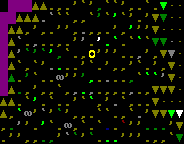- v50 information can now be added to pages in the main namespace. v0.47 information can still be found in the DF2014 namespace. See here for more details on the new versioning policy.
- Use this page to report any issues related to the migration.
Duplicated raws
v52.04 · v0.47.05 This article is about the current version of DF.Note that some content may still need to be updated. |
| This page includes mods. The content is not part of normal DF as released. Changing game files can sometimes cause unexpected results, and should always be done with care and caution. |
| This article is a stub. You can improve the article by expanding it. |
Duplication of raw file entries is a type of game bug, widely known in the community, due to the bizarre effects this particular bug has on world generation. It's usually caused by a modding accident, though some players duplicate raws on purpose to create a crazy glitched world.
The exact effects of the bug happen at the end of worldgen, and vary depending on type and amount of duplicated raw entries.
Duplicated creatures
Duplication of creature raws results in wrong creatures appearing in wrong places and assuming wrong roles during gameplay, with many messy and/or hilarious results. It has been known to cause cave crocodiles to live in houses, civilizations of elephants to form, camels to wear clothes, fluffy wamblers to pull wagons, and so on. It also causes creature materials to glitch, which likely results in civilians wearing clothing made out of liver tissue, chicken teeth, soap, or "unknown frozen creature substance", to name a few, and other weirdnesses, such as llama eggs being available on embark.
This type of raw file duplication is very prone to spontaneous crashing, and duplicating all creatures will almost certainly result in a crash during worldgen, so it's not advised to do this during regular play.
Duplicated plants
Duplication of plant raws likely results in generic grass replacing standard vegetation. Little is otherwise known about the subject.
Duplicated materials
Duplication of inorganic material raws results in wrong materials forming geological layers and inclusions, some of which normally don't appear within the world's crust. These can produce unusual resources when mined, such as metal boulders. Below is the list of what materials you can encounter, and how you can put them to use.
Displaced minerals
The amount of displaced minerals will depend on the place in which raw file duplication has occurred. Sometimes, you can even find entire layers composed of usable ore.
Misplaced soils
Soil, sand, and clay tiles can also be misplaced, which will likely result in aquifers being generated in unexpected places, such as in mineral deposits. The tiles themselves will be unusable in sand/clay production, however, unless they happen to form the entire layer.
Metal layers
Contrary to what you might think, these produce metal boulders when mined, which can either be melted into a meager amount of metal bars, or directly made into short swords the same way obsidian swords are made.
Evil weather materials
Evil weather materials have no melting or boiling point, and thus will always be mined as solids. These can be used either as basic construction material, or in jewelry, but not in stoneworking. Note that mining them and working with created 'boulders' is perfectly safe, but cave-in dust will transfer any syndromes of the material, likely turning the majority of your population into undead husks.
Divine fabric
While not fire-safe, divine fabric has an astonishingly-high base value of 300, making it perfect for decoration. Unfortunately, 'boulders' composed of it cannot be processed into thread, and can be worked only at a jeweler's workshop.
Divine metal
It is completely impervious to heat, and superior to anything other than adamantine. Mined boulders can be processed the same way as boulders of other metals, discussed above.
